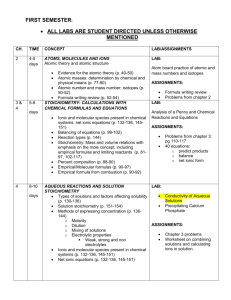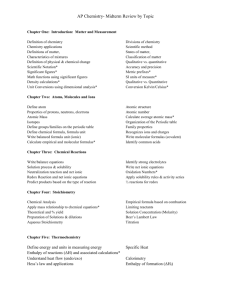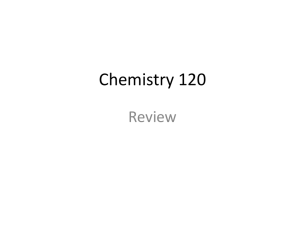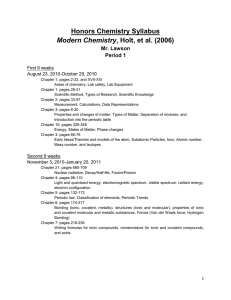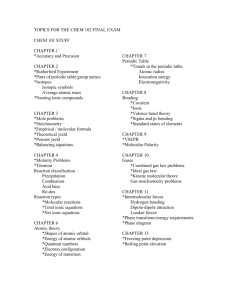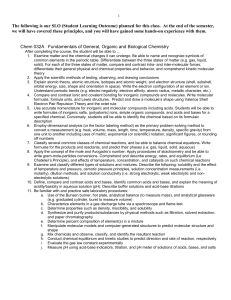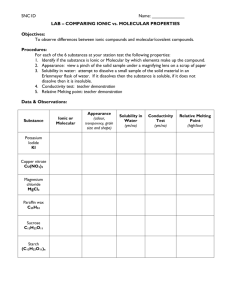*
advertisement
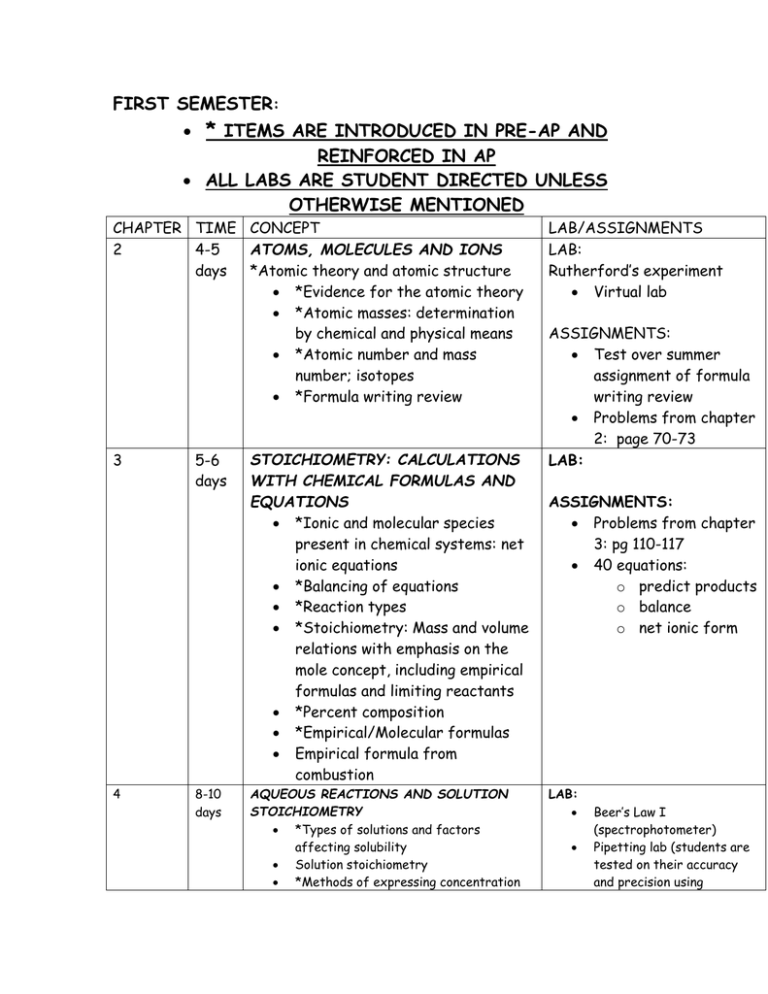
FIRST SEMESTER: * ITEMS ARE INTRODUCED IN PRE-AP AND REINFORCED IN AP ALL LABS ARE STUDENT DIRECTED UNLESS OTHERWISE MENTIONED CHAPTER TIME CONCEPT ATOMS, MOLECULES AND IONS 2 4-5 days *Atomic theory and atomic structure *Evidence for the atomic theory *Atomic masses: determination by chemical and physical means *Atomic number and mass number; isotopes *Formula writing review 3 4 5-6 days STOICHIOMETRY: CALCULATIONS WITH CHEMICAL FORMULAS AND EQUATIONS *Ionic and molecular species present in chemical systems: net ionic equations *Balancing of equations *Reaction types *Stoichiometry: Mass and volume relations with emphasis on the mole concept, including empirical formulas and limiting reactants *Percent composition *Empirical/Molecular formulas Empirical formula from combustion 8-10 days AQUEOUS REACTIONS AND SOLUTION STOICHIOMETRY *Types of solutions and factors affecting solubility Solution stoichiometry *Methods of expressing concentration LAB/ASSIGNMENTS LAB: Rutherford’s experiment Virtual lab ASSIGNMENTS: Test over summer assignment of formula writing review Problems from chapter 2: page 70-73 LAB: ASSIGNMENTS: Problems from chapter 3: pg 110-117 40 equations: o predict products o balance o net ionic form LAB: Beer’s Law I (spectrophotometer) Pipetting lab (students are tested on their accuracy and precision using *Molarity *Dilution Mixing of solutions *Electrolytic properties Weak, strong and non electrolytes Ionic and molecular species present in chemical systems: Net ionic equations o o o o 5 14-16 days 14 11 days 15 11 days THERMOCHEMISTRY State functions First law: change in enthalpy; heat of formation; heat of reaction; Hess’s law, heats of vaporization and fusion; calorimetry CHEMICAL KINETICS Concept of rate of reaction Use of experimental data and graphical analysis to determine reactant order, rate constants and reaction rate laws Effect of temperature change on rates Energy of activation; the role of catalysts The relationship between the ratedetermining step and a mechanism Half-lifes CHEMICAL EQUILIBRIUM Concept of dynamic equilibrium, physical and chemical, LeChatelier’s principle; equilibrium constants Quantitative treatment o Equilibrium constants for gaseous reactions: Kp,Kc serological/volumetric pipettes. Beer’s Law II (spectrophotometer) Titration lab Virtual (book demo) and hands on ASSIGNMENTS: Chapter 3 problems Worksheet on combining solutions and calculating ions in solution. LAB: Specific heat Hess’s Law ASSIGNMENTS: Book problems LAB: Factors affecting Rate (kit from FLINN) Crystal violet Lab with CBL o Determines order and activation energy ASSIGNMENTS: Book problems Determine order of reaction through graphical analysis LAB: LeChatelier principle (kit) SECOND SEMESTER 16 11 days ACID-BASE EQUILIBRIA Equilibrium constants for reactions in solution Constants for acids and bases: pK; pH Bronsted-Lowry Acids and Bases The auto-ionization of water LAB: Calculation of Ka of an acid (indicator) PH scale Indicators Strong acids & bases compared to weak acids and weak bases Relationship between Ka and Kb Acid-Base properties of salt solutions Acid-Base behavior and chemical structure Triprotic acids Lewis acids and bases 17 25days ADDITIONAL ASPECTS OF AQUEOUS EQUILIBRIA Common ion effect; buffers; hydrolysis Acid-base titration Solubility equilibria; solubility product constants and their application to precipitation and the dissolution of slightly soluble compounds Coordination complexes; amphoterism Precipitation reactions Qualitative analysis for metallic elements Descriptive chemistry o Relationships in periodic table 19 7 days 20 17days CHEMICAL THERMODYNAMICS Second law: entropy; free energy of formation; free energy of reaction; Dependence of change in free energy on enthalpy and entropy changes and temperature changes Relationship of change in free energy to equilibrium constants and electrode potentials ELECTROCHEMISTRY Oxidation-reduction reactions; balancing equations Oxidation number The role of the electron in oxidationreduction Electrochemistry’ electrolytic and galvanic cells; Faraday’s Lasw; standard half-cell potentials; Nernst equation; prediction of the direction of redox reactions Cell EMF under standard conditions Free energy and redox reactions Cell EMF under nonstandard conditions LAB: Titration of strong acid and strong base; standardization of a base Determination of molecular mass of a weak acid through titration Construction of a pH curve through titration Descriptive/qualitative analysis determination of unknown salts DEMO: LABS: The Potential of Electrochemical Cells(Salt bridge) Electrolysis of KI solution 6 3days 7 3-5 days 8 5 9 5 days 11 5-8days Electrolysis ELECTRONIC STRUCTURE OF ATOMS *Electron energy levels *Atomic spectra *Quantum numbers *Atomic orbitals *Aufbau, Pauli and Hund’s Rule PERIODIC PROPERTIES *Relationships in periodic table *atomic and ionic radii, ionization energies, electron affinities, oxidation states, electronegativity *effective nuclear charge, shielding affect, metallic character BASIC CONCEPTS OF CHEMICAL BONDING *Binding forces o Ionic o Covalent o Metallic hydrogen bonding o Van der Waals o London dispersion forces *Relationships to states, structure, and properties of matter *Polarity of bonds *Electronegativity Resonance structures *Exceptions to the octet rule Strengths of covalent bonds o Bond energy o Bond length MOLECULAR GEOMETRY AND BONDING THEORIES *Lewis structures Valence Bond: hybridization of orbitals, resonance, sigma and pi bonds *VSEPR Geometry of molecules and ions, structural isomerism of molecules and coordination complexes, dipole moments and relation of properties to structure INTERMOLECULAR FORCES, LIQUIDS AND SOLIDS States of matter Liquids and solids from the kinetic-molecular viewpoint LAB: Molecular geometry structures with balls and sticks and Styrofoam for the expanded octets. LAB: Triple point of dry ice Molecular mass determination using Phase diagrams of one-component systems Changes of state, including critical points and triple points Structure of solids; lattice energies PROPERTIES OF SOLUTIONS *Solution process *Saturated solutions and solubility *Factors affecting solubility *Ways of expressing concentration *Colligative properties Raoult’s Law Nonvolatile compared to volatile solutes Osmosis Nonideal behavior and quantitative methods Ideal solutions 13 10 5-8 days 5 days GASES *Characteristics of Gases *Gas Laws of ideal gases: Charles, Boyles, 21 2-3 days Grahams, Combined Gas Law, Daltons Law of Partial Pressures, Guy Lussac, and Graham’s Law of Effusion *Equation of State of an Ideal Gas *Kinetic molecular theory of gases o Interpretation of ideal gas laws on the basis of kinetic theory *Molecular effusion and diffusion *Real Gases: deviations from ideal behavior *Dependence of kinetic energy of molecules on temperature *Avogadro’s hypothesis and the mole concept NUCLEAR CHEMISTRY Nuclear equations Half-lives Radioactivity Chemical applications freezing and boiling points Evaporation and Intermolecular Attractions Using Conductivity to Find an Equivalence Point Vapor Pressure of Liquids LABS: Determination of molecular mass from a gas (butane)
